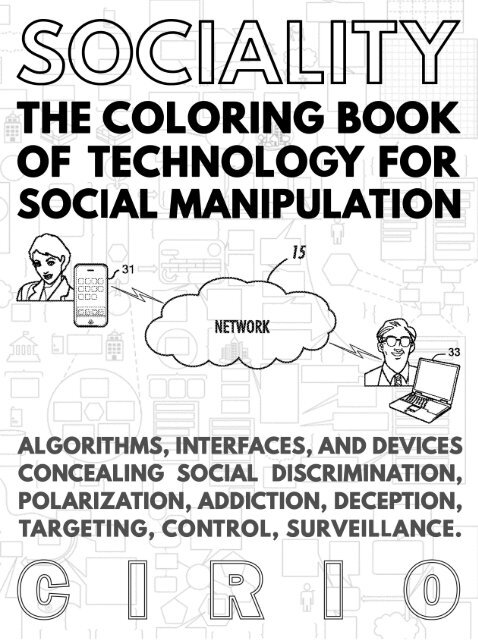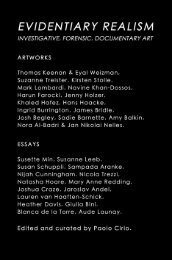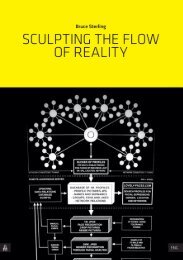SOCIALITY, the Coloring Book of Technology for Social Manipulation
This book contains over 250 selected patents that the artist Paolo Cirio found by sifting through over 20,000 inventions he published on the website https://sociality.today. The artist organized the patents into chapters such as Discrimination, Polarization, Addiction, Deception, Targeting, Control, and Surveillance. With this artwork, Cirio exposes inventions that employ devious psychological and profiling tactics through artificial intelligence, algorithms, data mining, and user interfaces. As artistic provocation, the Coloring Book of Technology for Social Manipulation proposes the cathartic, childlike exercise of coloring to both educate and inform through the visually rendered compositions of outlined flowcharts and patent titles.
This book contains over 250 selected patents that the artist Paolo Cirio found by sifting through over 20,000 inventions he published on the website https://sociality.today. The artist organized the patents into chapters such as Discrimination, Polarization, Addiction, Deception, Targeting, Control, and Surveillance. With this artwork, Cirio exposes inventions that employ devious psychological and profiling tactics through artificial intelligence, algorithms, data mining, and user interfaces. As artistic provocation, the Coloring Book of Technology for Social Manipulation proposes the cathartic, childlike exercise of coloring to both educate and inform through the visually rendered compositions of outlined flowcharts and patent titles.
- No tags were found...
Create successful ePaper yourself
Turn your PDF publications into a flip-book with our unique Google optimized e-Paper software.
“We understand <strong>the</strong> power <strong>of</strong> mass<br />
media, like television, advertising, etc.,<br />
<strong>the</strong>y teach this even at school. However,<br />
it’s not common knowledge how<br />
algorithms, user interfaces, and personal<br />
devices are much more powerful and<br />
sophisticated in manipulating people.<br />
This should be an educational issue and<br />
also a legislative one.”<br />
Paolo Cirio,<br />
Fast Company Interview, 2018
<strong>Social</strong>ity<br />
The <strong>Coloring</strong> <strong>Book</strong> <strong>of</strong> <strong>Technology</strong><br />
<strong>for</strong> <strong>Social</strong> <strong>Manipulation</strong><br />
by Paolo Cirio.<br />
This artist book is derived from Paolo Cirio’s artwork <strong>Social</strong>ity, <strong>for</strong><br />
which <strong>the</strong> artist collected and rated over twenty thousand patents <strong>of</strong><br />
technology enabling social manipulation. <strong>Social</strong>ity aims to raise<br />
awareness and engage <strong>the</strong> general public in tracking, flagging, and<br />
banning socially harmful in<strong>for</strong>mation technology.<br />
As artistic provocation, <strong>the</strong> <strong>Coloring</strong> <strong>Book</strong> <strong>of</strong> <strong>Technology</strong> <strong>for</strong> <strong>Social</strong><br />
<strong>Manipulation</strong> proposes <strong>the</strong> cathartic, childlike exercise <strong>of</strong> coloring to<br />
both educate and in<strong>for</strong>m through visually rendered compositions <strong>of</strong><br />
outlined flowcharts and patent titles. The patents featured in this<br />
publication range from <strong>the</strong> seemingly innocuous to <strong>the</strong> dystopian,<br />
reflecting on <strong>the</strong> in<strong>for</strong>mation technology companies attempts to<br />
program and control individuals and society.<br />
This first edition contains over 225 carefully selected and<br />
categorized patents that Paolo Cirio found by individually<br />
examining <strong>the</strong> first 4,000 patents from <strong>the</strong> over 20,000 rated<br />
automatically and published on <strong>the</strong> website https://sociality.today.<br />
The patents presented on <strong>the</strong> project website and in this coloring<br />
book were retrieved from <strong>the</strong> Google Patents plat<strong>for</strong>m through a<br />
custom-made script exploiting a vulnerability in <strong>the</strong> limits imposed<br />
by <strong>the</strong> search engine.<br />
This book aims to expose technology that employs devious<br />
psychological tactics through artificial intelligence, algorithms, data<br />
mining, interactive interfaces, social media plat<strong>for</strong>ms, and methods<br />
<strong>for</strong> targeting and tracking online users. In <strong>the</strong> <strong>Coloring</strong> <strong>Book</strong> <strong>of</strong><br />
<strong>Technology</strong> <strong>for</strong> <strong>Social</strong> <strong>Manipulation</strong>, <strong>the</strong> artist Paolo Cirio organized<br />
<strong>the</strong> patents into <strong>the</strong> chapters Discrimination, Polarization, Control,<br />
Addiction, Deception, <strong>Manipulation</strong>, Censorship, Targeting,<br />
Pr<strong>of</strong>iling, Biometrics, and Surveillance.
Utilizing <strong>the</strong> design <strong>of</strong> <strong>the</strong> coloring book, Cirio draws viewers into <strong>the</strong><br />
realm <strong>of</strong> manipulative technology, where uncanny plans to program<br />
and pr<strong>of</strong>ile people have become ubiquitous. <strong>Social</strong>ity reveals some<br />
<strong>of</strong> <strong>the</strong> first patents from this particular technological field, dated<br />
around 1998, and concludes in 2018, <strong>the</strong> year when nefarious social<br />
consequences <strong>of</strong> such technologies have become most evident and<br />
reported. These patents document <strong>the</strong> history <strong>of</strong> how humans began<br />
to be programmed by machines. In favor <strong>of</strong> a more ethical use <strong>of</strong><br />
technology, <strong>Social</strong>ity seeks to inspire public awareness regarding<br />
<strong>the</strong>se apparatuses, as our sociality is now being owned and traded<br />
by private companies without public scrutiny.<br />
These devices are <strong>of</strong>ten obscured by technological language, trade<br />
secrets, and <strong>the</strong> public’s general unawareness, inspiring <strong>the</strong> artist to<br />
develop a coloring book <strong>of</strong> such technology used <strong>for</strong> social<br />
manipulation. The documentary <strong>for</strong>m <strong>of</strong> this artwork aims to shed<br />
light on contemporary mechanisms <strong>of</strong> social control by showing<br />
evidence <strong>of</strong> complex technological systems and <strong>the</strong>ir role in enabling<br />
social discrimination, social bubbles, algorithmic bias, amplification<br />
<strong>of</strong> misin<strong>for</strong>mation, behavior modification, tech addiction, and<br />
corporate surveillance.<br />
Expanding from privacy and bias, this project focuses on technology<br />
<strong>for</strong> <strong>the</strong> manipulation <strong>of</strong> human behavior and psyche. Attention<br />
economy, steered social validation, and habit-<strong>for</strong>ming products can<br />
be psychologically damaging and impact social relationships to <strong>the</strong><br />
point <strong>of</strong> harming <strong>the</strong> fabric <strong>of</strong> society and endangering democracy.<br />
In this book, both artist and readers are tasked with per<strong>for</strong>ming<br />
oversight <strong>of</strong> invasive inventions designed to target demographics,<br />
push content, coerce interactions, and monitor people.<br />
The provocative and participatory component <strong>of</strong> coloring elicits<br />
engagement <strong>for</strong> collaborative critical reflection. Each image in this<br />
book includes short descriptions and patent numbers, acting as<br />
evidence that can be sent to legislators, academics, activists, and<br />
journalists advocating <strong>for</strong> regulation, while <strong>the</strong> visual strategy aims<br />
to make <strong>the</strong> project popular and emblematic.<br />
The <strong>Social</strong>ity book invites readers to discover and investigate by<br />
coloring compositions <strong>of</strong> flowcharts and texts, revealing how human<br />
sociality is being engineered and patented.
“It’s about behavior modification on<br />
a mass basis, with everyone under<br />
surveillance by <strong>the</strong>ir devices and<br />
receiving calculated stimulus to<br />
modify <strong>the</strong>m.”<br />
Jaron Lanier<br />
“<strong>Social</strong> media literally changes your<br />
relationship to society…exploiting a<br />
vulnerability in human psychology.”<br />
Sean Parker<br />
“The problem is <strong>the</strong> hijacking <strong>of</strong> <strong>the</strong><br />
human mind: systems that are better<br />
and better at steering what people<br />
are paying attention to, and better<br />
and better at steering what people<br />
do with <strong>the</strong>ir time than ever be<strong>for</strong>e.<br />
This system is better at hijacking<br />
your instincts than you are at<br />
controlling <strong>the</strong>m.”<br />
“It is about a civilization-scale<br />
mind-control-machine” and<br />
“<strong>the</strong> compulsive elements <strong>of</strong> <strong>the</strong>ir<br />
inventions.”<br />
Tristan Harris
“The short-term, dopamine-driven<br />
feedback loops...The social<br />
validation feedback loop...<br />
They are ripping apart <strong>the</strong> social<br />
fabric <strong>of</strong> how society works”<br />
Chamath Palihapitiya<br />
“We have several examples <strong>of</strong><br />
technology enabling us to do things<br />
which <strong>for</strong> various reasons, mainly<br />
ethical, we decide no to allow.<br />
For instance, we have agreed to<br />
establish bioethics boards and trust<br />
<strong>the</strong>m to per<strong>for</strong>m an oversight<br />
function regulating <strong>the</strong> indiscriminate<br />
use <strong>of</strong> technology on ethical grounds.<br />
Do <strong>the</strong> contenders <strong>of</strong> this dogma<br />
wish to allow unrestricted use <strong>of</strong><br />
biotechnology including development<br />
<strong>of</strong> biological arms?”<br />
Dan Shefet
Fur<strong>the</strong>r Reading<br />
Ten Arguments <strong>for</strong> Deleting Your <strong>Social</strong> Media Accounts Right Now<br />
by Jaron Lanier, Henry Holt and Co., 2018<br />
Re-Engineering Humanity<br />
by Brett Frischmann and Evan Selinger, Cambridge Press, 2018<br />
Sad by Design<br />
by Geert Lovink, Pluto Press, 2018<br />
Algorithms <strong>of</strong> Oppression<br />
by Safiya Noble, NYU Press, 2018<br />
Automating Inequality<br />
by Virginia Eubanks, St. Martin's Press, 2018<br />
Digital Sociology: The Reinvention <strong>of</strong> <strong>Social</strong> Research<br />
by Noortje Marres, Polity, 2017<br />
Weapons <strong>of</strong> Math Destruction<br />
by Cathy O'Neil, Broadway <strong>Book</strong>s, 2016<br />
Hooked: How to Build Habit-Forming Products<br />
by Nir Eyal, Portfolio, 2014<br />
Networks Without a Cause<br />
by Geert Lovink, Polity, 2012<br />
Program Or be Programmed<br />
by Douglas Rushk<strong>of</strong>f, OR <strong>Book</strong>s, 2010<br />
Advocacy Organizations<br />
Center <strong>for</strong> Humane <strong>Technology</strong>, U.S.<br />
Common Sense Media, U.S.<br />
Internet and Me, Europe
“We understand <strong>the</strong> power <strong>of</strong> mass<br />
media, like television, advertising, etc.,<br />
<strong>the</strong>y teach this even at school. However,<br />
it’s not common knowledge how<br />
algorithms, user interfaces, and personal<br />
devices are much more powerful and<br />
sophisticated in manipulating people.<br />
This should be an educational issue and<br />
also a legislative one.”<br />
Paolo Cirio,<br />
Fast Company Interview, 2018
<strong>Social</strong>ity,<br />
The <strong>Coloring</strong> <strong>Book</strong> <strong>of</strong> <strong>Technology</strong><br />
<strong>for</strong> <strong>Social</strong> <strong>Manipulation</strong><br />
by Paolo Cirio.<br />
COPYRIGHTS<br />
This artist book is created by Paolo Cirio LTD.<br />
Paolo Cirio holds <strong>the</strong> copyright <strong>of</strong> <strong>the</strong> artistic<br />
compositions made <strong>for</strong> this publication.<br />
The source material assembled <strong>for</strong> creating<br />
<strong>the</strong> publication belongs to <strong>the</strong> public domain.<br />
Creative Commons License:<br />
Attribution-NonCommercial 4.0 International<br />
More about this artwork and Cirio’s art at:<br />
https://PaoloCirio.net<br />
ISBN 9780359294039<br />
ISBN 978-0-359-29403-9 90000<br />
9<br />
780359<br />
294039










